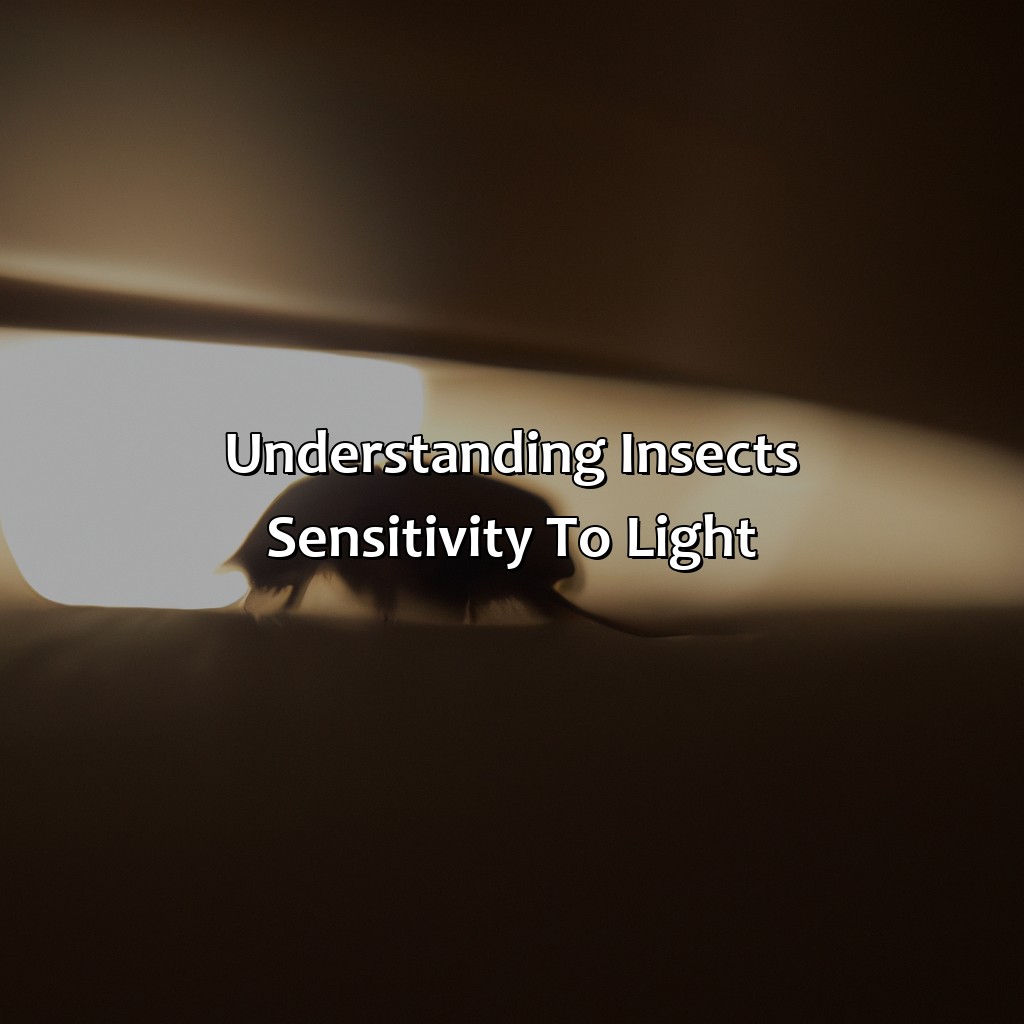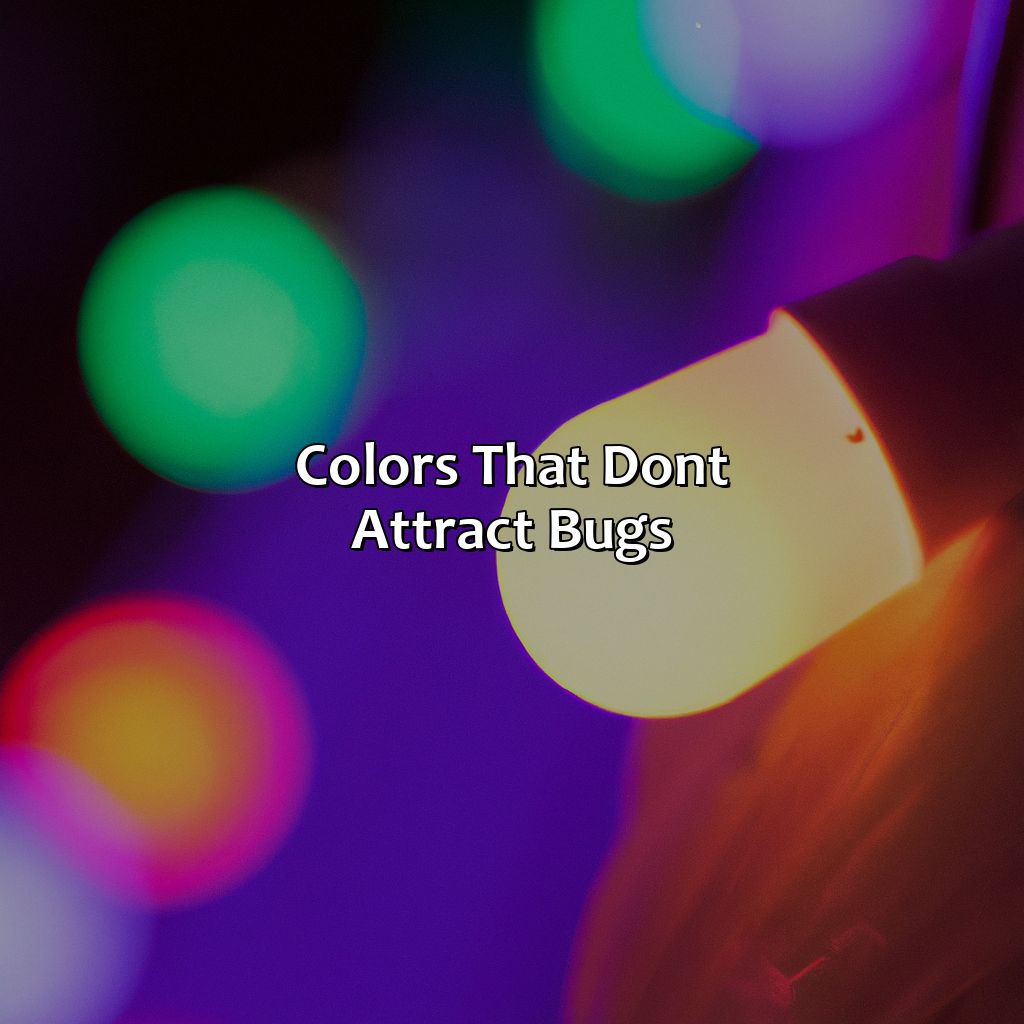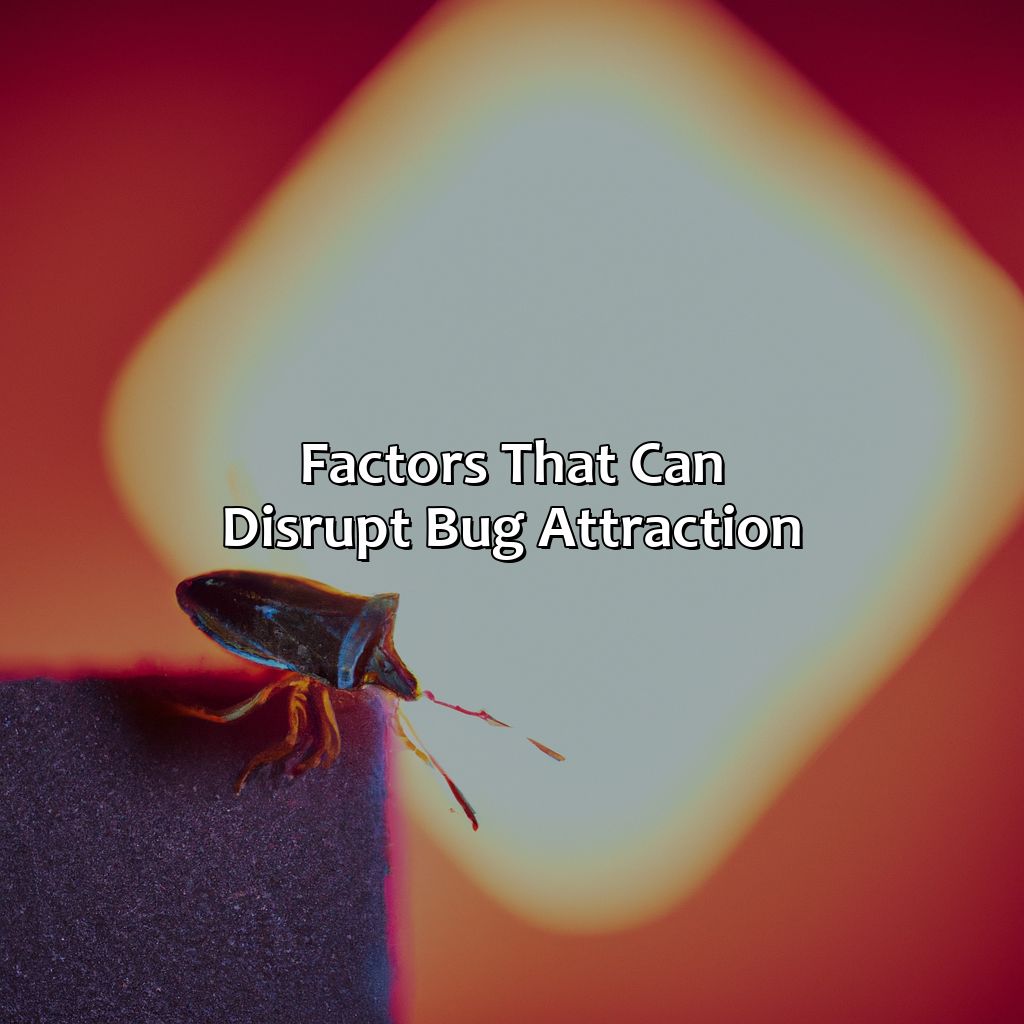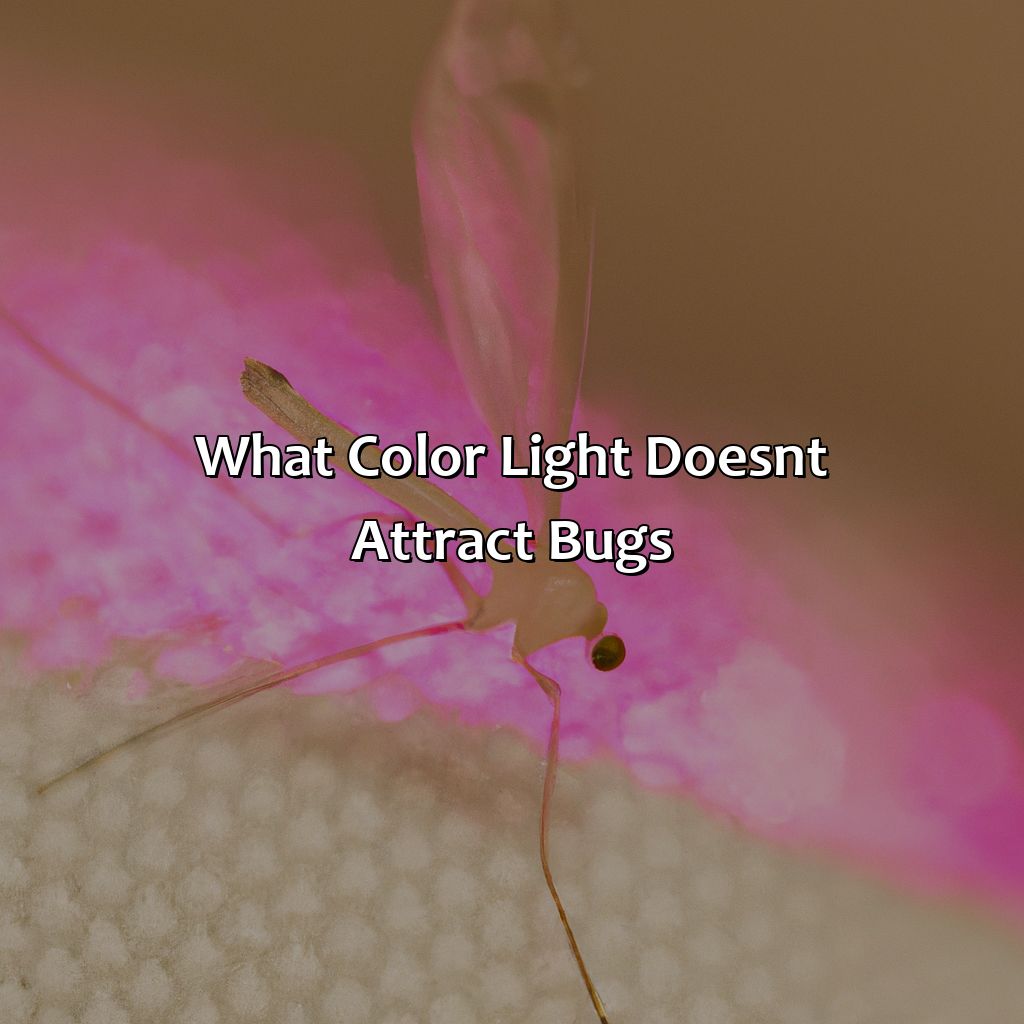Key Takeaway:
- Using yellow or amber-colored light bulbs can reduce attraction to bugs and insects, making them an ideal choice for outdoor lighting.
- LED bulbs are a great option for insect-resistant lighting, as they emit less UV light which tends to attract bugs.
- Other factors that can affect insect attraction to light include the brightness, duration, and direction of the light source, as well as the presence of other light sources nearby.
Explanation of the problem with bugs and lights
Bugs are attracted to light, causing them to swarm around outdoor lighting fixtures and annoying residents. This has been a nuisance for homeowners for many years. Lighting the surroundings of our homes is crucial for safety, comfort, and aesthetics; however, insect attraction to light has still been challenging to tackle.
Say goodbye to the annoying buzz of bugs with bug-resistant light bulbs.
Importance of finding a bulb that doesn’t attract bugs
Finding a bug-resistant light is crucial to prevent insects from being attracted to outdoor lighting sources. The choice of light color will determine whether or not bugs are drawn to the area, which can be an important consideration for many individuals.
Importance of finding a bulb that doesn’t attract bugs:
- Reduce the number of bugs around outdoor spaces
- Prevent bites and stings from insects
- Avoid damaging plants and crops caused by insect infestations
- Save money on pest control measures and maintenance costs
- Create a more pleasant environment for outdoor gatherings and activities
To achieve optimal results in reducing insect attraction, it’s important to understand the sensitivity of different insects to light. Factors such as color temperature, wavelength perception, and overall design can all play a role in how attractive lighting sources are to bugs.
It’s essential to find a sustainable solution as using bug-repelling chemical sprays harms the environment and health. Choosing lights with specific colors like yellow or amber can cause less disruption in the natural world while also preventing bugs from being drawn towards them.
Why do bugs love lights? They’re just drawn to the bright side like moths to a flame. Wait, they are moths to a flame.
Understanding Insects’ Sensitivity to Light

Photo Credits: colorscombo.com by Jeffrey Mitchell
Why are bugs drawn to light? Discover the answer!
Examine the factors of insect attraction to light and how various wavelengths can affect them. Uncover which colors of light are most appealing to bugs and why.
Dive into sub-sections:
- Factors Attracting Bugs to Light
- Insects’ Perception of Different Wavelengths
- Why Certain Colors Are More Appealing to Bugs
Factors that attract bugs to light
Light color and attraction are closely linked to insect vision. Factors such as brightness, timing, and light frequency can affect the attraction of insects towards lights. These factors can make certain colors more attractive to bugs than others. Understanding how these factors affect insect behavior is essential in finding a bulb that doesn’t attract bugs.
How insects see the world is not that different from how we see it, except for the fact that they would never be caught wearing reading glasses.
How insects perceive different wavelengths
Insects perceive different wavelengths in a unique way due to their vision. They are capable of perceiving ultraviolet light that is invisible to the human eye. This enables them to have a better visual ability, which helps them find food and mates, navigate through their environment, and avoid predators.
| Column 1 | Column 2 |
|---|---|
| Insect visual receptors | Different wavelength ranges perceived by bugs |
| Rhodopsin | Ultraviolet (300-400nm) |
| Blue-sensitive opsin | Blue (400-475nm) |
| Green-sensitive opsin | Green (475-525nm) |
| Red-sensitive opsin | Red (550-600 nm) |
| Long-wavelength-sensitive | Yellow (600-700 nm) |
Interestingly, insect vision is also affected by the intensity of light. The brighter the light, the more attracted they become towards it. Additionally, they can detect polarized light, which helps them navigate during specific times of day.
Understanding insect vision is important when selecting a wavelength range that doesn’t attract bugs. Opting for wavelengths on both ends of the spectrum outside of a bug’s range would make it less likely to attract insects compared to other lights that emit wavelengths within an insect’s detection range.
With insect vision being such an important factor in determining what type of bulb you should use, choosing one that doesn’t attract bugs can be difficult without doing proper research. If you want to keep your outdoor spaces free from pesky insects like mosquitoes and flies, it is critical to select bulbs with proper wavelength ranges tailored specifically towards what bugs may or may not see clearly.
Looks like bugs have a preference for colors, just like my ex who only wore red.
Why some colors are more attractive to bugs than others
Certain colors of light are more attractive to insects than others. This attraction is caused by the insect’s sensitivity to different wavelengths of light. Understanding how insects perceive light can help in choosing a light color that does not attract them. Insect eyes have photoreceptors that respond to ultraviolet, blue, and green wavelengths of light. These receptors allow bugs to navigate and find food sources at night. However, they are also attracted to lights with these wavelengths as they appear brighter and more appealing.
In addition to blue and green light, insects are also attracted to yellow and white lights as they mimic natural sunlight. Insects use sunlight for navigation during the day, so these colors can trick them into thinking it is still daytime and interfere with their natural rhythms. On the other hand, red and orange lights are less attractive as they have longer wavelengths that do not activate insect photoreceptors in the same way.
To reduce insect attraction, choosing a light color with a low Kelvin temperature of 3000K or lower can be more effective as it emits less blue light which is most attractive to bugs. LED bulbs are also recommended as they emit less heat than traditional incandescent bulbs which may attract insects due to their warmth. Other factors such as the brightness of the bulb and its placement can also affect insect attraction.
A study conducted by the University of Bristol found that LED bulbs emitting warm-colored light (around 1800-2000K) reduced insect attraction by 55%, compared to cool-colored LEDs (6000K). This shows that choosing the right light color can significantly reduce bug attraction.
Turns out, the right color temperature can make bugs feel as unwelcome as a party crasher in a hazmat suit.
Colors That Don’t Attract Bugs

Photo Credits: colorscombo.com by Aaron Green
Want an insect-free outdoor space? Check out insect-proof lights! This section breaks it down into four sub-sections:
- We’ll discuss yellow light bulbs for bug protection.
- Plus, the benefit of LED bulbs for insect-repelling light.
- We’ll recommend the best bulbs for outdoor lighting that are bug-resistant.
- Last, we’ll discuss other factors that affect insect attraction, such as insect-free lighting and natural bug repellent light.
The best color temperature for outdoor lighting
For optimal bug protection, it is crucial to select the ideal color temperature for outdoor lighting. The right range of kelvins can play a vital role in deterring bugs from approaching and disrupting your outdoor activities. Yellow light bulbs are an excellent option to consider due to their yellow or amber hue, which is less attractive to insects than other colors.
Yellow light bulbs in the 2000K-3000K range emit minimally shorter wavelengths that bugs do not perceive as well as longer wavelengths such as 5000K-6500K commonly found in blue-white LEDs, which attracts more insects. While these light bulbs may seem dimmer at first glance, they provide adequate visibility for most outdoor activities and significantly lower the possibility of pest disturbances.
Install LED bulbs with yellow tones, particularly those with a low blue wavelength component and low color rendering index (CRI) preferable amid 80-90. These considerations reduce attractiveness to insects while providing enough brightness for safe navigation around your property.
Ensure recessed or downward-facing fixtures limit upward illumination spilling onto roofs and trees as this can confuse bugs leading them towards your home.
Thus by choosing yellow light bulbs with optimal temperature range one can enhance their experience of outdoor activities without any unwanted interference from buzzing insects.
LED bulbs not only save money and energy, but they also emit insect-repelling light colors.
The benefit of using LED bulbs
LED bulbs have become a popular option for outdoor lighting due to their various benefits. One of the main benefits that make them highly preferable is their insect repelling light color. An LED bulb emits a cool white light, which does not attract insects like other colors do.
Here are some advantages of using LED bulbs for bug reduction:
- LED bulbs do not produce infrared radiation, which attracts certain bugs.
- They emit bright light without producing much heat, which deters bugs from flying towards it.
- They have a longer lifespan compared to traditional bulbs, which means less frequent replacement and cost savings in the long term.
- LEDs use less energy than other types of bulbs, making them an environmentally-friendly option.
- They are available in different color temperatures that can help with reducing insect attraction while enhancing the aesthetic quality of your outdoor space.
In addition to these benefits, LED bulbs offer improved visibility and clarity at night, making them ideal for security and safety purposes as well.
It’s worth noting that the intensity and brightness of any light source can still attract insects despite its color. Therefore, it’s important to choose an appropriate lumen output that suits your specific lighting needs while being mindful about bug attraction.
According to research conducted by the University of Georgia with assistance from pest control company Orkin, cool white LEDs were found to be most effective in reducing insect attraction.
Say goodbye to pesky bugs and hello to bug-resistant bulbs with these recommended outdoor lighting options.
Recommended bulbs for outdoor lighting
To choose the best bulbs for outdoor lighting that are resistant to insects, it is important to consider factors like color temperature and bulb type. Here are some recommended insect-resistant bulbs for outdoor lighting:
- LED bulbs with a color temperature of 2700K or lower as they emit less blue light that tends to attract insects.
- Yellow “bug lights” which do not attract bugs because they have longer wavelengths and less visible blue light.
- Mercury Vapor, High Pressure Sodium, and Dark Sky Friendly CFL Bulbs as they emit short-wavelength light which is less attractive to insects.
- Violet-colored LED Bug Zappers that lure flying pests and kill them upon contact with electrified grids without producing any UV radiation harmful to humans.
It is essential to keep in mind that while selecting the right bulb can certainly limit bug attraction, other environmental factors such as humidity, location, time of year, and brightness can also play a vital role.
Additionally, choosing insect-repelling plants like marigolds or citronella candles can further help in warding off pests from the surroundings. Citronella oil mixed with other essential oils such as lemongrass oil may also be used in diffusers around the yard to repel bugs naturally.
Get your insect-free lighting fix with these natural bug repellent light tips.
Other factors that may affect insect attraction
Factors that may impact the attraction of insects to light include the intensity and duration of lighting, proximity to other bright lights, and even weather conditions. Insects are typically more attracted to lights at night due to the absence of natural sunlight, making it easier for them to perceive artificial light sources. Other factors, such as air currents and humidity levels can also amplify their attraction.
Effective insect-free lighting requires careful consideration and adjustment of all these contributing factors. Opting for natural bug repellent LED bulbs is a step in the right direction when trying to avoid pesky bugs outdoors.
Say goodbye to pesky bugs with these anti-pest lights and insect repelling plants.
Factors That Can Disrupt Bug Attraction

Photo Credits: colorscombo.com by Kenneth Gonzalez
Combat bug attraction with additional strategies. For example, fly-repelling or mosquito-free lights. Additionally, use insect-repelling plants like citronella candles and plant-based repellents. Lastly, invest in bug-resistant lamps or mosquito-resistant lights. All of these can help reduce the attraction of bugs towards anti-pest light and insect repelling plants.
Additional strategies for reducing bug attraction
To further reduce insect attraction, other strategies can be employed besides using colors that don’t attract bugs.
Some additional fly-repellent light options include:
- installing motion sensors to turn off lights when not in use
- using dimmer switches to create a less appealing environment for insects
Another natural way to reduce mosquito attraction is by adding insect-repelling plants such as lavender, lemongrass and citronella around light fixtures. Additionally, bug-repelling products like citronella candles or oil diffusers can also work in outdoor living spaces alongside the mosquito-free light strategy.
It’s important to note that other factors may affect insect attraction besides just light color temperature, including the time of day and location of the lighting fixture. However, incorporating these additional strategies can further reduce the likelihood of attracting unwanted bugs to your outdoor space.
Green thumbs rejoice, these insect-repelling plants are the perfect addition to any backyard party (citronella candles not included).
Insect-repelling plants
Plants with Insect-deterrent Properties
Various plant species can repel insects effectively and efficiently. By strategically placing these plants in areas around homes, patios or any outdoor area, it can provide a natural barrier against unwelcome bugs. Some environmentally friendly alternatives to synthetic insect repellents such as DEET are available through plant-based insect repellents. Here are some examples:
- Citronella Grass
- Lemon Balm
- Marigolds
- Rosemary
- Lavender
- Catnip
These plants contain chemicals that render them unattractive to bugs or simply repel them by scent or taste. They provide a natural alternative without affecting the environment adversely. Planting an array of these plants can be used for cooking, decoration and practical pest control.
Pro Tip: For maximum insect-repellent effectiveness, place the planters near windows and outside entryways to help keep bugs out of your home. Combine this with citronella candles for enhanced protection against bugs when enjoying time outside..
Keep those pesky bugs at bay with bug-resistant lamps and mosquito-resistant light options.
Citronella candles and other bug-repelling products
Insect Repelling Products & Citronella Candles:
An effective way to keep insects away from your outdoor area is by incorporating bug-repelling products and citronella candles into your pest-management strategy. These products emit a scent that mosquitoes and other insects find unpleasant, making them less likely to linger in the area.
- Using insect repelling plants can help reduce bugs in the surrounding area.
- Citronella candles are an excellent option for adding ambiance while keeping pests at bay.
- Electric mosquito zappers work by attracting insects with UV light and then killing them.
- Mosquito nets provide excellent protection against mosquito bites when you’re sleeping outdoors or inside a tent.
- Bug spray can help keep bugs off of you while you spend time outside.
- Bug-resistant lamps, such as yellow bulbs, can also provide an added layer of protection against mosquitoes and other flying insects.
Another helpful way to use these products is by placing them around seating and dining areas. You can strategically place these items throughout your outdoor space so that they’re not too obtrusive but still fight against unwanted pests.
Pro Tip: Consider using bug-resistant lamps to maximize the coverage area without sacrificing design aesthetics.
Say goodbye to pesky bugs and hello to a bug-free zone with the right insect control light bulbs.
Summary of key takeaways
Bug-free light bulbs and insect-free outdoor lighting are essential to maintaining a comfortable and pest-free outdoor environment. To summarize the key points discussed in this article, here are some takeaways:
- Understanding insects’ sensitivity to light is crucial in choosing the right bulbs for outdoor lighting
- The color temperature and type of bulbs used greatly affect insect attraction
- LED bulbs with specific color temperatures are recommended for bug reduction
- Insect-repelling plants can also contribute to reducing bug attraction outdoors
- Citronella candles may provide additional protection against bugs during outdoor activities
It is important to note that while proper bulb selection plays a significant role in reducing bug attraction, it should not be relied on entirely. Other factors such as weather conditions and time of day also play a part, and incorporating multiple strategies can ensure maximum efficacy.
A friend once shared their experience with installing bug-free light bulbs in their backyard. They were initially skeptical but noticed a significant decrease in bug activity around their patio area. Their guests also appreciated the lack of pesky bugs interrupting their dinner parties.
Final thoughts on choosing the right light color for bug reduction
As we’ve learned, finding the right light color for bug reduction is crucial in mosquito-repellent outdoor lighting and insect control strategies. Using a recommended color temperature of 2700-3000K for outdoor bulbs in LED lighting can significantly decrease insect attraction. Additionally, reducing the blue content in your lighting can help to lessen the number of insects drawn towards it. Using bug-repelling plants and products such as citronella candles, when combined with reduced blue light sources, is also an effective strategy.
Pro Tip: It’s essential to remember that finding the perfect solution may take some trial and error, but by implementing these strategies, you’re well on your way to creating an insect-controlled outdoor space.
Five Facts About What Color Light Doesn’t Attract Bugs:
- ✅ Insects are drawn to shorter wavelengths of light, such as blue and ultraviolet, but are less attracted to longer wavelengths like yellow and red. (Source: Scientific American)
- ✅ LED lights emit less UV radiation, making them less attractive to insects. (Source: Home Guides)
- ✅ Yellow “bug lights” have a special coating that blocks short-wavelength light, making them less attractive to insects. (Source: Wired)
- ✅ It’s not just the color of the light that affects insect attraction, but also its brightness and duration. (Source: Popular Science)
- ✅ Some insects, like mosquitoes, can still be attracted to yellow or red light, but are less likely to bite in its presence. (Source: Science News)
FAQs about What Color Light Doesn’T Attract Bugs
What color light doesn’t attract bugs?
The color of light that doesn’t attract bugs is a warm amber or yellow color. These colors have longer wavelengths and are less attractive to insects than white or blue lights.
Why are some colors more attractive to bugs?
Bugs are attracted to certain colors because they see the world differently than humans. They are more sensitive to shorter wavelengths of light, such as blue and ultraviolet light. These colors appear brighter and more attractive to insects.
What types of bugs are attracted to white or blue lights?
A wide variety of bugs are attracted to white or blue lights, including mosquitoes, moths, flies, and beetles. These insects are highly attracted to the short wavelengths of light emitted by these colors.
Can I use different colored lights inside and outside my home?
Absolutely! Using warm amber or yellow lights outside can help reduce the number of bugs buzzing around your patio or porch. Inside your home, you may prefer to use white or blue lights for brighter and more natural-looking light.
Do LED lights attract bugs?
Yes, LED lights can attract bugs just like any other type of light. However, choosing warm amber or yellow LEDs can help reduce the number of bugs that are attracted to your lights.
What other measures can I take to reduce bugs around my home?
Along with using warm amber or yellow lights, you can also reduce the number of bugs around your home by keeping your outdoor areas clean and free of standing water. Installing screens on windows and doors can also help keep flying insects from entering your home.






